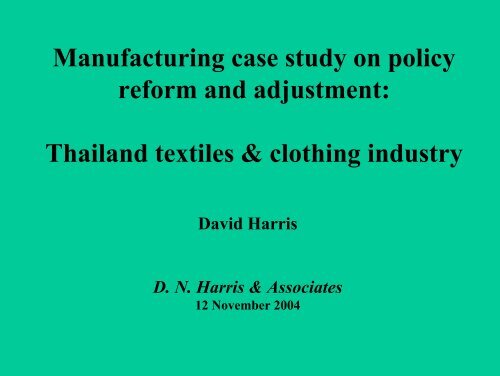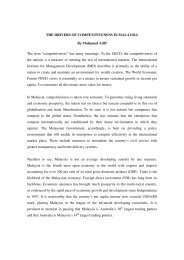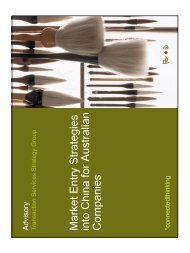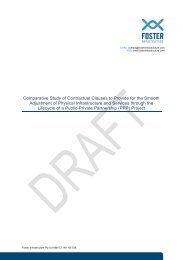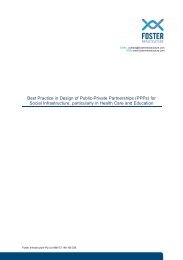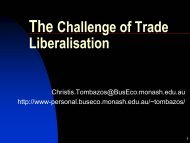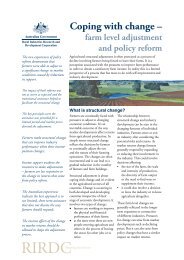Thailand textiles & clothing industry
Thailand textiles & clothing industry
Thailand textiles & clothing industry
You also want an ePaper? Increase the reach of your titles
YUMPU automatically turns print PDFs into web optimized ePapers that Google loves.
Manufacturing case study on policy<br />
reform and adjustment:<br />
<strong>Thailand</strong> <strong>textiles</strong> & <strong>clothing</strong> <strong>industry</strong><br />
David Harris<br />
D. N. Harris & Associates<br />
12 November 2004
<strong>Thailand</strong> textile & <strong>clothing</strong> <strong>industry</strong><br />
Case study on reform for... a DC <strong>industry</strong>... an export <strong>industry</strong><br />
Textile & <strong>clothing</strong> a major <strong>industry</strong> in <strong>Thailand</strong>:<br />
• around 1 million jobs<br />
• became largest single export <strong>industry</strong><br />
• US$4.5 billion export sales in 1996<br />
• > 25% of value added in manufacturing<br />
Developed from competitive advantage of low cost labor:<br />
• was highly protected – 1970’s, 1980’s<br />
• strong growth in production, exports<br />
• trade reforms in 1990’s<br />
• adjustment in capacity, jobs, <strong>industry</strong> specialisation
T&C <strong>industry</strong> development<br />
T&C <strong>industry</strong> has different areas of specialisation:<br />
• based on stages of manufacturing<br />
• up-stream versus down stream<br />
• fibre…. yarn… fabrics… <strong>clothing</strong> production<br />
Rapid expansion in <strong>textiles</strong> (yarn, fabrics) but strong import<br />
competition in late 1950’s:<br />
• cotton <strong>textiles</strong> from Pakistan<br />
• adjustment pressures in capacity, jobs<br />
Tariff protection & manufacturing assistance (1960’s):<br />
• recovery in capacity<br />
• Japanese investment in synthetic fibres
T&C <strong>industry</strong> support policies<br />
During 1970’s Govt. policy a combination of:<br />
• import protection<br />
• capacity restrictions<br />
• <strong>industry</strong> promotion<br />
Very high tariffs & highly regulated:<br />
• tariff protection raised returns & stimulated growth<br />
• ban on capacity expansion<br />
• no new firms<br />
• objective was to stop excess production<br />
Strong growth in exports allowed easing of regulations:<br />
• but restrictions remained on suppliers to domestic market
T&C <strong>industry</strong> support policies<br />
Capacity regulations not effective:<br />
• not properly enforced<br />
• yarn & fabric capacity expanded in 1980’s<br />
Pressure for policy reform because of export growth:<br />
• increased yarn exports….<br />
• reduced domestic supplies for fabric producers….<br />
• domestic yarn prices increased, > world price<br />
• tariff protection raised price of imported yarn<br />
Govt. lifted capacity restrictions in 1987:<br />
• new firms, increased capacity, new technology
T&C trade policy reforms<br />
In the early 1990’s high tariffs on fabric and <strong>clothing</strong>, lower<br />
tariffs on yarn:<br />
• 30% tariff on yarn in 1992<br />
• 60% tariff on fabrics<br />
• 60% tariff on <strong>clothing</strong><br />
Gradual reduction in tariffs during the 1990’s:<br />
• 10% tariff on yarn in 1997<br />
• 20% tariff on fabrics<br />
• 30% tariff on <strong>clothing</strong><br />
Larger reduction in protection for up-stream activities:<br />
• largest cut in yarns
Structural features of T&C <strong>industry</strong><br />
Structural characteristics of <strong>industry</strong> reflects competitive<br />
advantages and policy arrangements<br />
Yarn production is capital intensive, low labor intensity:<br />
• spinning technology key to efficiency<br />
• small number of firms<br />
• import competition based on better technology, scale<br />
advantages – lower costs of production<br />
Fabric production less capital intensive, more labor intensive:<br />
• weaving technology key to efficiency<br />
• more firms<br />
• import competition based on technology, lower labor costs,<br />
scale advantages
Trade in T&C products<br />
Clothing production limited capital, highly labor intensive:<br />
• labor costs key to efficiency<br />
• many firms<br />
• simple technology encourages small scale firms<br />
• sub-contracting – cutting, assembly, finishing<br />
• import competition based on lower labor costs<br />
Exports & imports of <strong>textiles</strong> – differences for up-stream &<br />
down stream activities:<br />
• mid 1990’s <strong>clothing</strong> 73% of exports<br />
• fabrics 14% of exports<br />
• yarn & fibre 11% of exports<br />
• exports worth US$4.5 billion
Trade in T&C products<br />
Most imports to supply fabric sector:<br />
• no <strong>clothing</strong> imports – competitive domestic suppliers<br />
• some yarn imports – increased capacity, new technology,<br />
scale gains improved domestic competitiveness<br />
• strong demand for fabric imports<br />
• partly quality issues but….<br />
• fashion changes need variety of fabrics<br />
Production and trade growth attracted more labor:<br />
• 70% increase in <strong>clothing</strong> sector (mid 80’s to mid 90’s)…<br />
• almost 1 million employed…<br />
• 80% increase in fabric/yarn sector – 270,000 employed
Effects of T&C policy reform<br />
Policy reform period has been lengthy:<br />
• began late 1980’s with end of capacity restrictions<br />
• followed by gradual tariff cuts in 1990’s<br />
What happen?<br />
• <strong>industry</strong> expanded, exports expanded<br />
• initially growth in down stream activities<br />
• tariff protection remained – higher input costs (yarn)<br />
Strong growth in <strong>clothing</strong> & fabric exports<br />
• built on labor cost competitiveness and…..<br />
• investment in capacity and….<br />
• investment in weaving technology (fabric production)
Structural adjustment in T&C <strong>industry</strong><br />
Later, <strong>industry</strong> had to adapt to lower import protection:<br />
• reduced input costs (yarn)….<br />
• helped competitiveness of down stream activities….<br />
• but rising wages was eroding competitiveness<br />
From around mid-1990’s export performance of <strong>clothing</strong>,<br />
fabrics declined:<br />
• competition from lower cost export suppliers<br />
• labor costs were more competitive<br />
• adjustment issue for firms – market focus?<br />
Down stream firms increasingly focused on domestic sales:<br />
• significant import protection<br />
• adjustment issue for labor?
Structural adjustment in T&C <strong>industry</strong><br />
Trade reforms re-oriented <strong>industry</strong> to up-stream activities:<br />
• <strong>industry</strong> growth shifting towards yarn<br />
• limited protection, low labor intensity<br />
Reduced yarn protection required adjustment by up-stream<br />
firms to improve competitiveness:<br />
• had to get scale efficiencies<br />
• had to invest in technology<br />
Effect was strong growth in yarn production:<br />
• competitive supplier to down stream sectors<br />
• import penetration began to decline<br />
• strong growth in yarn exports
Adjustment in down stream activities<br />
Adjustment pressures in <strong>clothing</strong> & fabric sectors:<br />
• <strong>clothing</strong> production up 300% (mid 70’s to mid 90’s)…<br />
• fabric production up 600%...<br />
• but then growth stopped, exports declined<br />
• import competition constrained<br />
• increasing dependency on protection<br />
• labor adjustment issue building-up<br />
Import protection was slowing adjustment that must<br />
inevitably occur:<br />
• changed from major export <strong>industry</strong> to sheltered from<br />
import competition<br />
• political issues – a major employer<br />
• alternative employment, retraining?
A ‘lesson’ in reform and adjustment<br />
Adjustment pressures in fabric & <strong>clothing</strong> sectors primarily<br />
driven by market forces:<br />
• loss of labor competitiveness<br />
• trade reform had limited effect….<br />
• export <strong>industry</strong> was competitive against imports….<br />
• tariff protection irrelevant but then essential?<br />
Adjustment pressures in yarn sectors primarily driven by<br />
trade reform:<br />
• firms had to adapt, improve efficiency<br />
• a ‘positive force’ for change – successful<br />
• no adjustment assistance
A ‘lesson’ in reform and adjustment<br />
Up-stream sector – bigger trade reform created an incentive<br />
for change:<br />
• promoted economic efficiency<br />
• community benefits from some jobs growth<br />
Down stream sector – limited trade reform diluted incentive<br />
for change:<br />
• slowed adjustment through efficiency improvements<br />
• one community group gains – job losses slowed….<br />
• but general community paying higher prices<br />
Major exchange rate changes affect adjustment pressures:<br />
• but is it temporary,…..a false sense of security?<br />
• ex rates change in other countries
Managing the adjustment issue<br />
Down stream <strong>industry</strong> adjustment issue is evident:<br />
• inevitable contraction….<br />
• unless competitiveness can be improved….<br />
• fundamental issue is labor costs…..<br />
• trade agreements will increase the pressure<br />
Moving forward has to recognise:<br />
• some labor/firms have to exit <strong>industry</strong><br />
• remaining firms have to change – specialisation, R&D,<br />
technology, off-shore labor inputs?<br />
• adjustment assistance could help, but….<br />
• incentives, distortionary effects important<br />
• be pro-active – don’t wait for the trade deals


